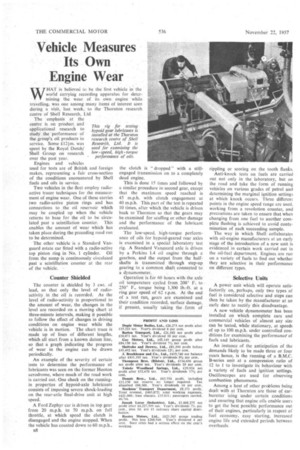Vehicle Measures Its Own Engine Wear
Page 42

If you've noticed an error in this article please click here to report it so we can fix it.
WHAT is believed to be the first vehicle in the world carrying recording apparatus for deter
mining the wear of its own engine while travelling, was one among many items of interest seen during a visit, last week, to the Thornton research centre of Shell Research, Ltd.
The emphasis at the centre is on product, and applicational research to study the performance of the group's oil products in service. Some £124m. was spent by the Royal Dutch/ Shell Group on research over the past year.
Engines and vehicles used for tests are of British and foreign makes, representing a fair cross-section of the conditions encountered by Shell fuels and oils in service.
Two vehicles in the fleet employ radioactive tracer techniques for the measurement of engine wear. One of these carries two radio-active piston rings and has connections to the oil reservoir which may be coupled up when the vehicle returns to base for the oil to be circulated past a scintillation counter. This enables the amount of wear which has taken place during the preceding road run to be determined.
The other vehicle is a Standard Vanguard estate car fitted with a radio-active top piston ring in No. 1 cylinder. Oil from the sump is continuously circulated past a scintillation counter at the rear of the vehicle. This rig for testing hypold gear lubricants is installed at the Thornton research centre of Shell Research, Ltd. It is used for examining the low speed, high torque performance of oils.
Counter Shielded
The counter is shielded by 3 cwt. of lead, so that only the level of radioactivity in the oil is recorded. As the level of radio-activity is proportional to the amount of wear, the changes in the level are recorded on a Moving chart at three-minute intervals, making it possible to follow the effect of changes in driving conditions on engine wear while the vehicle is in motion. The chart trace is made up of lines of different lengths, which all start from a known datum line, so that a graph indicating the progress of wear in the engine can be drawn periodically.
An example of the severity of certain tests to determine the performance of lubricants was seen on the former Hooton aerodrome, where much of the road work is carried out. One check on the runningin properties of hypoid-axle lubricants consists of imposing severe shock-loading on the rear-axle final-drive unit at high speed.
A Ford Zephyr car is driven in top gear from 20 m.p.h. to 70 m.p.h. on full throttle, at which speed the clutch is disengaged and the engine stopped. When the vehicle has coasted down to 60 m.p.h., B8 the clutch is " dropped" with a stillengaged transmission on to a completely dead engine.
This is done 15 times and followed by a similar procedure in second gear, except that the maximum speed reached is 45 m.p.h. with clutch engagement at 40 m.p.h. This part of the test is repeated 10 times, after which the vehicle is driven back to Thornton so that the gears may be examined for scuffing or other damage and the performance of the lubricant evaluated.
The low-speed, high-torque performance of oils for hypoid-geared rear axles is examined in a special laboratory test rig. A Standard Vanguard axle is driven by a Perkins L4 oil engine through a gearbox. and the output from the halfshafts is transmitted through step-up gearing to a common shaft connected to a dynamometer.
Operation is for 60 hours with the axle oil temperature cycled from 200' F. to 250° F., torque being 1,300 lb.-ft. at a ring gear speed of 62 r.p.m. At the end of a test run, gears are examined and their condition recorded, surface damage, if present, usually taking the . form of
rippling or scoring on the tooth flanks.
Anti-knock tests on fuels are carried out not only in the laboratory, but on the road and take the form of running vehicles on various grades of petrol and determining the marginal ignition settings at which knock occurs. Three different points in the engine speed range are used, working from a revolution counter, and precautions are taken to ensure that when changing from one fuel to another complete flushing is achieved to avoid contamination of each succeeding sample.
The way in which Shell. collaborates with oil-engine manufacturers at an early stage of the introduction of a new unit is evidenced in certain work carried out in the oil-fuel department. Engines are run on a variety of fuels to find out whether they are selective in their performance on different types,
Selective Units A power unit which will operate satisfactorily on,. perhaps, only two types of fuel is considered selective and steps can then be taken by the manufacturer at an early date to rectify this disadvantage.
A new vehicle dynamometer has been installed on which complete cars and commercial vehicles of almost any size can be tested, while stationary, at speeds of up to 100 m.p.h. under controlled conditions for examining the performance of fuels and lubricants.
An instance of the anticipation of the demands likely to be made three or four years hence, is the running of a B.M.C. B-series unit at a compression ratio of 12 to I to investigate its behaviour with a variety of fuels and ignition settings. Oscilloscopes are used for observing combustion phenomena.
Among a host of other problems being dealt with at Thornton are those of carburetter icing under certain conditions and ensuring that engine oils enable users to get the best possible performance out of their engines, particularly in respect of fuel economy, easy starting, increased engine life and extended periods between overhauls.




























































































